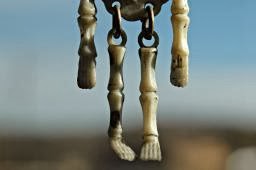Exercising With Osteoporosis: Build Bones, Stay Strong
 When you think about what your
body’s bone structure looks like, flashbacks of the lanky skeleton hanging lifelessly in your science class are probably the first thoughts that come to
mind. The bones in your body, however, are much livelier than their classroom
counterparts as they are made up of living and growing tissue that continues to
get denser as you become a young adult. As you age into adulthood, you can
begin to lose more bone mass than your body produces, putting you at a higher
risk of bone breakage and osteoporosis.
When you think about what your
body’s bone structure looks like, flashbacks of the lanky skeleton hanging lifelessly in your science class are probably the first thoughts that come to
mind. The bones in your body, however, are much livelier than their classroom
counterparts as they are made up of living and growing tissue that continues to
get denser as you become a young adult. As you age into adulthood, you can
begin to lose more bone mass than your body produces, putting you at a higher
risk of bone breakage and osteoporosis.Reports from the National Osteoporosis Foundation (NOF) earlier this year indicated that 57 million Americans are affected by low bone density conditions or osteoporosis. By 2020, the NOF estimates that half of all Americans over the age of 50 are expected to have low bone density or osteoporosis. Whether you have osteoporosis now or at risk of developing this common condition, there are steps you can start taking today to help reduce the rate of bone loss in your body.
Feed Your Bones, Build Strength
If you are one of the millions of Americans suffering from osteoporosis, it’s important to be proactive about reducing the loss of bone density by adopting healthy exercise and nutrition habits. A diet rich in Vitamin D and calcium can help make bones harder and stronger, while a well-balanced nutrition approach that includes a mix of dairy, lean protein, fruits, vegetables and healthy fats can feed your body’s framework with the nutrients and minerals it needs to support weak bone areas and reduce the risk of bone loss.
To enhance the flexibility and strength of your body’s foundation, it also is important to keep the bones moving with a combination of weight-bearing cardio, muscle strengthening and core balance exercises, says Sue Teoli, personal trainer and studio owner at Fitness Together New Canaan. The NOF recommends 30 minutes of weight-bearing exercises daily (walking, elliptical, swimming, stair climbing), a combination of upper body and lower body muscle strengthening exercises (using body weight or resistance equipment) two to three days per week, and a variation of balance, posture and functional exercises each day depending on the area you are the weakest.
“It’s imperative to keep exercising if you have osteoporosis,” Teoli advises. “Anytime you improve your muscle strength, it’s good for your body. But, when you have osteoporosis, exercising can strengthen your bones first and foremost, while helping to slow down and prevent your bones from deteriorating.”
Break Out of the Cycle of Bone Loss by Getting Active Safely
Many people with osteoporosis may be reluctant to exercise as they may be afraid of getting hurt, breaking a bone or making their condition worse. While it’s recommended to consult with your doctor before starting any fitness routine, it can be very beneficial to the health of your skeletal and muscular systems when you focus on improving your physical fitness strength, balance and mobility.
“I tell all my clients, but especially my older ones, that strength in the lower back, abs and core is one of the most important things for your body,” says Teoli. “When you balance, you engage every muscle in your body. I think it’s important to focus on core strength and balance whether you have osteoporosis or not.”
It’s always important to think safety first when starting any workout routine by being aware of the inherent risks and staying in tune with how your body feels before, during and after you work out. Teoli advises her clients with osteoporosis to be aware of the following precautions before they start working out:
Refrain from high-intensity interval training as the jarring, jumping and high joint impact typically associated with these types of workouts increases the risk of bone damage and breakage.
- Never flex your spine forward like when doing a traditional sit-up as this movement puts too much strain on the vulnerable sections of your spine and mid-section. Instead, opt for other less forward-bending core movements such as the plank.
- Be careful with bending and twisting your body in different directions, as these movements can increase the risk of compression fractures in the spine.
If you have osteoporosis and are ready to start an exercise program to build your bone strength and physical fitness levels, Teoli suggests going back to the basics. A sample workout plan that she would suggest for her clients with osteoporosis includes the following elements.
- Upper body strength movement like a modified push up.
- Lower body strength movement like a body weight squat while leaning against a fitness ball along the wall or straight leg lifts if you have knee issues.
- Core exercises such as planks or balance exercises using a BOSU ball.
- Weight-bearing cardio movements such as walking, stair climbing or elliptical.

No comments:
Post a Comment